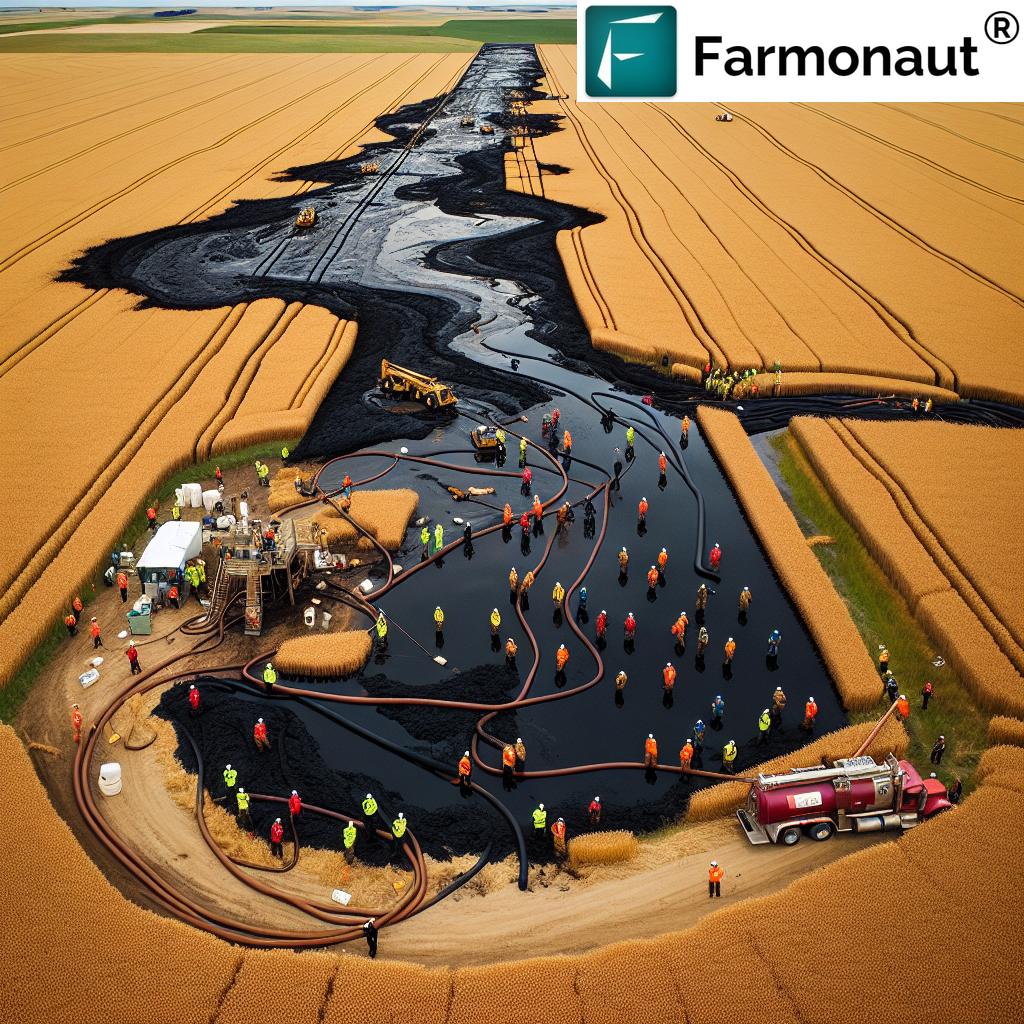Breaking News: Keystone Pipeline Rupture in North Dakota Sparks Environmental Concerns and Industry Debate
“The Keystone pipeline rupture in North Dakota was detected by a pressure drop, leading to swift containment within 24 hours.”
In the early hours of Tuesday morning, the tranquil agricultural fields near Fort Ransom, North Dakota, became the unexpected epicenter of a significant environmental incident. The Keystone oil pipeline, a crucial artery in North America’s energy infrastructure, experienced a rupture, sending shockwaves through the industry and reigniting debates about pipeline safety and environmental protection. As we delve into this breaking news, we’ll explore the immediate impact, the response efforts, and the broader implications for the energy sector and environmental policies.
The Incident Unfolds: A Timeline of Events
At approximately 7:44 AM local time, the serene North Dakota landscape was disrupted by what employees described as a “mechanical bang” emanating from the Keystone pipeline. This sound, as innocuous as it might seem, was the harbinger of a significant oil spill that would soon capture national attention. Let’s break down the sequence of events:
- 7:44 AM: An alert employee at the pump station hears an unusual noise and immediately takes action.
- Within 2 minutes: The pipeline is shut down, showcasing the swift response protocols in place.
- Shortly after: Oil is reported surfacing approximately 300 yards (274 meters) south of the pump station in an agricultural field.
- Immediate response: Emergency personnel are dispatched to the site to assess and contain the situation.
This rapid sequence of events highlights the critical importance of human vigilance and automated systems in pipeline operations. The quick action taken by the on-site employee potentially averted a much larger disaster, demonstrating the value of well-trained personnel in environmental protection efforts.

Environmental Impact and Immediate Concerns
The spill’s confinement to an agricultural field is both a relief and a concern. While it spared nearby water bodies from immediate contamination, the impact on soil quality and local ecosystems remains a pressing issue. Here’s what we know about the environmental situation:
- Spill Location: Confined to an agricultural field, limiting immediate spread.
- Water Bodies: A nearby ephemeral stream, which only flows part of the year, was not impacted but was isolated as a precautionary measure.
- Soil Contamination: The extent of soil contamination is yet to be fully assessed, raising concerns about long-term agricultural impacts.
- Wildlife: Initial reports suggest no immediate impact on local wildlife, but monitoring continues.
The environmental impact of such spills can be far-reaching, affecting not just the immediate area but potentially having long-term consequences for soil health, groundwater, and local ecosystems. This incident underscores the critical need for advanced monitoring and rapid response systems in pipeline operations.
In situations like these, technologies such as those offered by Farmonaut’s carbon footprinting solutions can play a crucial role. These tools can help assess and monitor the environmental impact of such incidents, providing valuable data for cleanup efforts and long-term ecosystem recovery planning.
Industry Response and Containment Efforts
The response to the Keystone pipeline rupture has been swift and multifaceted, involving various stakeholders from the industry and regulatory bodies. South Bow, the liquid pipeline business managing the pipeline, has taken immediate steps to address the situation:
- Pipeline Shutdown: The affected segment was isolated promptly after leak detection systems identified a pressure drop.
- Resource Mobilization: Containment resources and operations teams were quickly dispatched to the site.
- Safety Focus: The company emphasized that their primary concern is the safety of onsite personnel and mitigating environmental risks.
- Collaboration: South Bow is working closely with local authorities and environmental agencies to manage the incident effectively.
This incident highlights the critical importance of advanced leak detection systems and well-trained personnel in pipeline operations. The quick response time demonstrates the industry’s commitment to safety and environmental protection, but it also raises questions about the adequacy of current preventive measures.
Investigating the Cause: Unanswered Questions
As the immediate containment efforts continue, investigators are turning their attention to the crucial question: What caused the Keystone pipeline rupture? Several factors are under scrutiny:
- Mechanical Failure: The reported “mechanical bang” suggests a possible equipment malfunction.
- Pipeline Integrity: Assessments of the pipeline’s overall condition and maintenance history are underway.
- Environmental Factors: Investigators are considering whether external factors, such as ground movement or extreme weather conditions, played a role.
- Operational Procedures: A review of operational protocols and their implementation is part of the investigation.
The cause of the rupture remains unclear, and the volume of crude oil spilled is yet to be determined. These unknowns are critical pieces of the puzzle that will inform future preventive measures and industry practices.
“The Keystone pipeline incident near Fort Ransom, ND, has reignited debates on balancing energy infrastructure with environmental protection across 1,000+ miles.”
The Broader Context: Keystone Pipeline’s History and Controversies
To fully understand the significance of this incident, it’s essential to consider the Keystone pipeline’s history and the controversies surrounding it:
- Construction and Cost: The Keystone Pipeline was constructed in 2010 at a cost of $5.2 billion.
- Route: It carries crude oil across Saskatchewan and Manitoba, through North Dakota, South Dakota, Nebraska, Kansas, and Missouri to refineries in Illinois and Oklahoma.
- Management Change: Originally constructed by TC Energy, the pipeline is now managed by South Bow as of 2024.
- Keystone XL Extension: Proposed in 2008, this extension has been at the center of political debates for over a decade.
The Keystone XL extension, in particular, has been a political hot potato:
- Halted by former President Barack Obama
- Revived by President Donald Trump
- Canceled again by President Joe Biden on his first day in office in January 2021
- TC Energy ultimately abandoned the project in June 2021
This latest incident adds another layer to the ongoing debate about the balance between energy infrastructure development and environmental protection. It raises questions about the long-term viability and safety of large-scale pipeline projects.
Environmental Concerns and Industry Debates
The Keystone pipeline rupture has reignited long-standing debates within the energy sector and among environmental advocates. Key points of contention include:
- Pipeline Safety: Critics argue that incidents like these highlight the inherent risks of oil pipelines, especially when they traverse sensitive ecosystems or agricultural lands.
- Energy Security: Proponents of the pipeline emphasize its role in ensuring North American energy independence and economic benefits.
- Environmental Protection: The incident has renewed calls for stricter regulations and more robust environmental safeguards in pipeline operations.
- Alternative Energy: Some argue that such incidents underscore the need to accelerate the transition to renewable energy sources.
These debates are not just academic; they have real-world implications for policy-making, industry practices, and future energy infrastructure projects. The outcome of these discussions could shape the future of North American energy policy for years to come.
Technological Solutions and Future Prevention
In light of this incident, there’s a growing focus on technological solutions to enhance pipeline safety and environmental protection. Advanced monitoring systems, like those used in precision agriculture, could play a crucial role in preventing and mitigating such incidents in the future.
For instance, Farmonaut’s crop plantation and forest advisory services utilize satellite imagery and AI to monitor large areas for changes in vegetation health. Similar technology could be adapted for pipeline monitoring, potentially detecting leaks before they become major incidents.
Other technological advancements being explored include:
- Advanced Leak Detection Systems: Utilizing machine learning algorithms to identify even minor pressure changes.
- Drone Surveillance: Regular aerial inspections using drones equipped with thermal imaging cameras.
- Smart Pigging: Enhanced in-line inspection tools that can detect pipeline wall thinning and potential weak points.
- Fiber Optic Sensing: Continuous monitoring of pipeline integrity using fiber optic cables.
These technologies, combined with rigorous maintenance schedules and stringent safety protocols, could significantly reduce the risk of future pipeline incidents.
Economic and Job Market Implications
The Keystone pipeline project, particularly its XL extension, has been closely tied to job creation and economic growth. The cancellation of the Keystone XL project led to significant job losses, highlighting the complex relationship between energy infrastructure, employment, and environmental concerns.
- Job Losses: The cancellation of Keystone XL resulted in thousands of job losses.
- Economic Impact: Local communities along the pipeline route have felt the economic repercussions of the project’s cancellation.
- Future Prospects: There’s ongoing discussion about potential job creation in renewable energy sectors as an alternative to traditional oil and gas jobs.
This latest incident adds another dimension to these economic considerations, potentially influencing future decisions on similar infrastructure projects.
International Relations and Energy Policies
The Keystone pipeline is not just a domestic issue for the United States; it has significant implications for international relations, particularly with Canada. The project has been a key topic in U.S.-Canada diplomatic discussions for years.
- Canadian Interests: The pipeline is crucial for transporting Canadian oil to U.S. markets.
- Policy Shifts: Changes in U.S. administrations have led to policy fluctuations, affecting bilateral relations.
- Future Collaborations: This incident may influence future energy cooperation between the two nations.
In January, Danielle Smith, the premier of Alberta, Canada, expressed interest in discussing the potential reopening of the pipeline project with a future Trump administration, indicating that the debate over the Keystone pipeline is far from over.
Regulatory Landscape and Future Policy Directions
The Keystone pipeline rupture is likely to have significant implications for the regulatory landscape governing pipeline operations and environmental protection. Key areas that may see increased scrutiny include:
- Safety Standards: Stricter regulations on pipeline construction, maintenance, and monitoring may be implemented.
- Environmental Assessments: More comprehensive and frequent environmental impact studies could be mandated for pipeline projects.
- Emergency Response Protocols: Enhanced requirements for rapid response and containment strategies in case of spills.
- Transparency and Reporting: Increased demands for public disclosure of pipeline operations and incident reports.
These potential regulatory changes could have far-reaching effects on the energy industry, potentially influencing everything from project approval processes to operational costs.
Comparative Analysis: Keystone Pipeline Rupture Impact and Response
| Aspect | Current Incident | Previous Incidents | Industry Standard |
|---|---|---|---|
| Spill Volume (estimated) | Under investigation | 383,000 gallons (2019 incident) | Varies; aim for zero |
| Detection Method | Pressure drop & employee observation | Various automated systems | Multi-layered detection systems |
| Response Time | Within 2 minutes | Typically within 10-15 minutes | As fast as possible, ideally < 5 minutes |
| Environmental Impact | Limited to agricultural field | Varied, some affecting water bodies | Aim for minimal to no impact |
| Containment Measures | Swift isolation of affected area | Varied, often including berms and skimmers | Rapid deployment of containment resources |
| Long-term Monitoring Plans | To be determined | Typically years of soil and water testing | Comprehensive, multi-year monitoring |
The Role of Technology in Pipeline Safety
As we look to the future of pipeline safety, technology will undoubtedly play a crucial role. Advanced monitoring systems, similar to those used in precision agriculture, could revolutionize how we detect and prevent pipeline incidents.
For instance, Farmonaut’s fleet management solutions demonstrate how satellite technology and AI can be used to monitor and manage large-scale operations efficiently. Similar principles could be applied to pipeline monitoring, potentially detecting issues before they escalate into major incidents.
Other technological advancements that could enhance pipeline safety include:
- AI-powered predictive maintenance: Using machine learning to predict potential failures before they occur.
- Blockchain for supply chain transparency: Enhancing traceability and accountability in pipeline operations.
- IoT sensors: Deploying a network of smart sensors along pipelines for real-time monitoring.
- Virtual and Augmented Reality: For enhanced training of pipeline operators and maintenance crews.
These technologies, when integrated with robust safety protocols and regulations, have the potential to significantly reduce the risk of pipeline incidents in the future.
Community Impact and Public Perception
The Keystone pipeline rupture near Fort Ransom has not only environmental and economic implications but also significant social impacts on local communities. Understanding these effects is crucial for developing comprehensive response strategies and shaping future policies.
- Local Concerns: Residents near the spill site are understandably worried about potential health risks and long-term environmental damage.
- Agricultural Impact: Farmers in the affected area are concerned about soil contamination and its effect on future crop yields.
- Public Trust: Incidents like these can erode public confidence in pipeline safety and the oil industry as a whole.
- Community Engagement: There’s an increased demand for transparency and community involvement in pipeline operations and safety measures.
Addressing these community concerns is vital for maintaining public support for energy infrastructure projects. Companies and regulators must prioritize open communication and community engagement to rebuild trust and ensure that local voices are heard in decision-making processes.
The Future of Energy Infrastructure
As we reflect on the Keystone pipeline rupture and its implications, it’s clear that the incident will have far-reaching consequences for the future of energy infrastructure in North America. Key considerations for the future include:
- Balancing Energy Needs and Environmental Protection: Finding ways to meet growing energy demands while minimizing environmental risks.
- Investing in Alternative Energy Sources: Accelerating the development of renewable energy infrastructure to reduce reliance on fossil fuels.
- Upgrading Existing Infrastructure: Modernizing aging pipelines and implementing advanced safety technologies.
- Policy and Regulatory Evolution: Developing more robust and adaptive regulatory frameworks to address emerging challenges in energy infrastructure.
The path forward will require collaboration between industry leaders, policymakers, environmental experts, and local communities to create sustainable and safe energy solutions for the future.
Conclusion: Lessons Learned and Moving Forward
The Keystone pipeline rupture in North Dakota serves as a stark reminder of the challenges and responsibilities associated with managing critical energy infrastructure. While the immediate response to the incident was swift, preventing major environmental damage, it has nonetheless reignited important debates about pipeline safety, environmental protection, and the future of energy policy in North America.
Key takeaways from this incident include:
- The crucial role of advanced detection systems and well-trained personnel in preventing and responding to pipeline incidents.
- The need for continuous improvement in pipeline safety technologies and protocols.
- The importance of balancing energy needs with environmental protection and community concerns.
- The potential for technological innovations, such as those seen in precision agriculture, to enhance pipeline monitoring and safety.
As we move forward, it’s clear that addressing these challenges will require a multifaceted approach involving technological innovation, policy reform, and enhanced collaboration between industry stakeholders, regulators, and local communities. The lessons learned from this incident will undoubtedly shape the future of pipeline operations and energy infrastructure development in North America and beyond.
In this evolving landscape, technologies like those offered by Farmonaut for agricultural monitoring and management could play an increasingly important role in enhancing safety and efficiency across various industries, including energy infrastructure. By leveraging advanced satellite imagery, AI, and data analytics, we can work towards a future where incidents like the Keystone pipeline rupture become increasingly rare, ensuring a safer and more sustainable energy infrastructure for generations to come.
FAQ Section
Q1: What caused the Keystone pipeline rupture in North Dakota?
A1: The exact cause of the rupture is still under investigation. Initial reports indicate that a “mechanical bang” was heard before the leak was detected, suggesting a possible equipment malfunction. However, factors such as pipeline integrity, environmental conditions, and operational procedures are all being examined as potential contributors to the incident.
Q2: How much oil was spilled in the Keystone pipeline rupture?
A2: The precise volume of crude oil spilled has not been determined yet. Investigations are ongoing to assess the extent of the spill. Previous incidents involving the Keystone pipeline have resulted in spills of varying sizes, with a 2019 incident releasing about 383,000 gallons of oil.
Q3: What immediate actions were taken to contain the spill?
A3: The response to the spill was swift. Within two minutes of detecting the issue, the pipeline was shut down. Emergency personnel were immediately dispatched to the site. The affected segment of the pipeline was isolated, and containment resources were mobilized to the area. A nearby ephemeral stream was also isolated as a precautionary measure, although it was not impacted by the spill.
Q4: How will this incident affect the local environment and agriculture?
A4: The spill was confined to an agricultural field, which limits its immediate spread but raises concerns about soil contamination. The long-term impact on soil quality and local ecosystems is yet to be fully assessed. Ongoing monitoring will be crucial to understand and mitigate any potential effects on agriculture and the local environment.
Q5: What are the implications of this incident for future pipeline projects?
A5: This incident is likely to intensify debates about pipeline safety and environmental protection. It may lead to stricter regulations, enhanced safety measures, and more rigorous approval processes for future pipeline projects. There could also be increased investment in alternative energy sources and infrastructure as a result of growing concerns about the safety and environmental impact of oil pipelines.
Earn With Farmonaut: Earn 20% recurring commission with Farmonaut’s affiliate program by sharing your promo code and helping farmers save 10%. Onboard 10 Elite farmers monthly to earn a minimum of $148,000 annually—start now and grow your income!
For more information on Farmonaut’s advanced agricultural solutions, visit our API page or explore our API Developer Docs.













